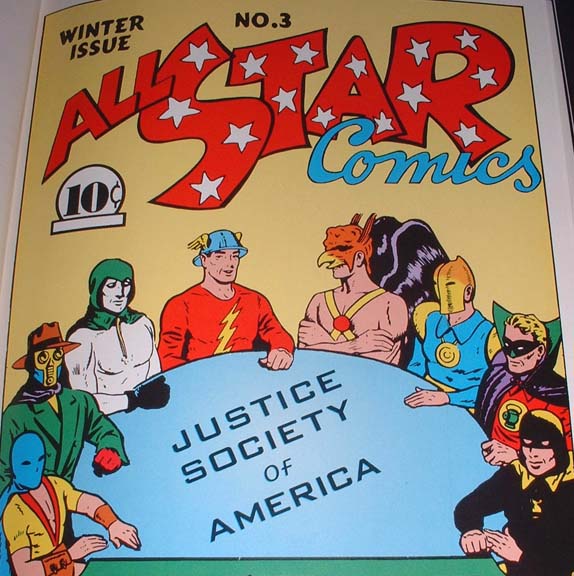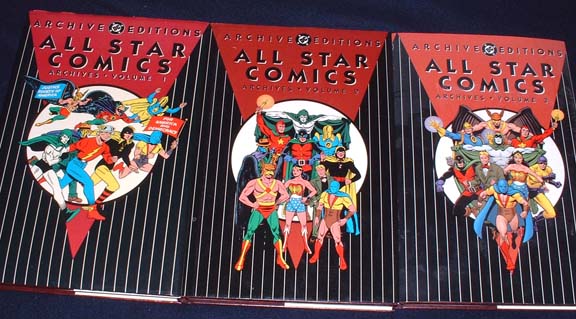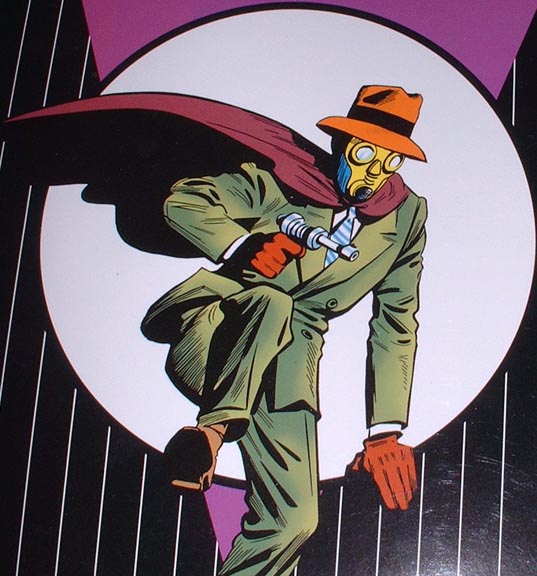I promised in my first blog post that I would discuss my ongoing project of creating custom action figures based on the original Justice Society of America. I guess it’s long overdue for me to get started. As most comic fan knows, the JSA appeared from 1940 to the early 50’s in All-Star Comics and featured an ensemble of second-stringer super heroes banding together to tackle a major threat. Although Superman and Batman were listed as honorary members, they never actually participated in any of the stories. The JSA was designed to showcase the lesser known heroes on DC’s roster. In fact, once a character, such as The Flash, became popular enough to have his own title, he left the JSA. All the JSA members were languishing in back-up features, and their participation in each JSA story was essentially as a back-up player.
As most comic fan knows, the JSA appeared from 1940 to the early 50’s in All-Star Comics and featured an ensemble of second-stringer super heroes banding together to tackle a major threat. Although Superman and Batman were listed as honorary members, they never actually participated in any of the stories. The JSA was designed to showcase the lesser known heroes on DC’s roster. In fact, once a character, such as The Flash, became popular enough to have his own title, he left the JSA. All the JSA members were languishing in back-up features, and their participation in each JSA story was essentially as a back-up player.
You see, the early comics were 64 pages in length with about 54 pages devoted to actual comic content. In All-Star Comics, the JSA would have a story which would span all 54 pages, but the story was cleverly divided into chapters (6 or 8 pages in length) in which each member of the JSA completed a solo task contributing to the overall completion of the mission. Each chapter was drawn by the artist who normally drew the character in his/her other features, so there was no visual continuity at all. You would go from the highly detailed artwork on a Hawkman chapter into the amateurish artwork on a Dr. Midnite chapter. An opening and closing chapter, which set up and concluded the story, was drawn by one artist who had to render all the heroes. These were the oddest looking chapters in each comic, especially if the artist couldn’t quite capture the proper look of certain heroes.
 Anyway, I never got to see any of these stories until the late 90s when DC Comics started putting out the hardcover compilations of the early All-Star issues. My first encounters with JSA were during the Justice League/Justice Society team-ups in the 70s. About once a year, Justice League of America would team up with the JSA which, in the DC Universe of the time, existed in a different dimension called Earth-2. The JSA members had aged normally since the 1940s, so they appeared in the 70s as gray-haired, wrinkled old fogies who still had rock hard bodies with which to fill out the tights. I thought the whole thing was a bit odd, but since I had enjoyed reading reprints of stories featuring the Golden Age super heroes, I found it amusing to see them as older but still active. Then I read Jim Steranko’s History of the Comics and learned about the All-Star Comics which I described earlier. I wanted desperately to see how these book-length comic stories worked, but there was no way I could afford any of those old comics even if I could get to a comic show to buy them. I didn’t even know about comic shows back then, and comic stores were rare. Twenty-five years later, I finally was able to read the stories and I got a huge kick out of them. Shortly thereafter, I got into making custom action figures, and I knew I wanted to create my own 12’’ JSA.
Anyway, I never got to see any of these stories until the late 90s when DC Comics started putting out the hardcover compilations of the early All-Star issues. My first encounters with JSA were during the Justice League/Justice Society team-ups in the 70s. About once a year, Justice League of America would team up with the JSA which, in the DC Universe of the time, existed in a different dimension called Earth-2. The JSA members had aged normally since the 1940s, so they appeared in the 70s as gray-haired, wrinkled old fogies who still had rock hard bodies with which to fill out the tights. I thought the whole thing was a bit odd, but since I had enjoyed reading reprints of stories featuring the Golden Age super heroes, I found it amusing to see them as older but still active. Then I read Jim Steranko’s History of the Comics and learned about the All-Star Comics which I described earlier. I wanted desperately to see how these book-length comic stories worked, but there was no way I could afford any of those old comics even if I could get to a comic show to buy them. I didn’t even know about comic shows back then, and comic stores were rare. Twenty-five years later, I finally was able to read the stories and I got a huge kick out of them. Shortly thereafter, I got into making custom action figures, and I knew I wanted to create my own 12’’ JSA.
The thing that intrigued me the most about the Golden Age heroes was their costumes. Since super heroes were a new invention in the late 30s and early 40s, their costumes were based on any number of references from wrestlers to pirates to early literary heroes like Zorro and The Scarlet Pimpernel. Unlike the Silver Age heroes who took their cue from the big guys Superman and Batman, the Golden Age do-gooders had unique, if not a little clunky, styles. They almost looked like they put together their outfits using leftovers from the attic, which heightened the reality of the characters for me. This also made the prospect of creating custom figure versions all the more interesting. By far the oddest looking member of the team was Sandman, so I naturally had to start with him. In my next post, I will describe the creation of my Sandman action figure.
 As most comic fan knows, the JSA appeared from 1940 to the early 50’s in All-Star Comics and featured an ensemble of second-stringer super heroes banding together to tackle a major threat. Although Superman and Batman were listed as honorary members, they never actually participated in any of the stories. The JSA was designed to showcase the lesser known heroes on DC’s roster. In fact, once a character, such as The Flash, became popular enough to have his own title, he left the JSA. All the JSA members were languishing in back-up features, and their participation in each JSA story was essentially as a back-up player.
As most comic fan knows, the JSA appeared from 1940 to the early 50’s in All-Star Comics and featured an ensemble of second-stringer super heroes banding together to tackle a major threat. Although Superman and Batman were listed as honorary members, they never actually participated in any of the stories. The JSA was designed to showcase the lesser known heroes on DC’s roster. In fact, once a character, such as The Flash, became popular enough to have his own title, he left the JSA. All the JSA members were languishing in back-up features, and their participation in each JSA story was essentially as a back-up player. Anyway, I never got to see any of these stories until the late 90s when DC Comics started putting out the hardcover compilations of the early All-Star issues. My first encounters with JSA were during the Justice League/Justice Society team-ups in the 70s. About once a year, Justice League of
Anyway, I never got to see any of these stories until the late 90s when DC Comics started putting out the hardcover compilations of the early All-Star issues. My first encounters with JSA were during the Justice League/Justice Society team-ups in the 70s. About once a year, Justice League of 




No comments:
Post a Comment